September 9, 2012 at 4:21 pm
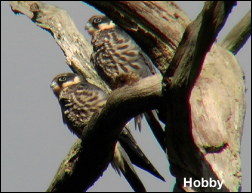
Apart from last week’s Kingfisher disaster the period June to late August has been the busiest I have ever had with the camera. The fact that this has fallen during the wettest Summer in over a century is amazing. The two juvenile Hobbies were the icing on the cake and something I have waited a long time to see.
At Hopwood the Swallows are now fledging their last broods of young. A change in the golf club’s attitude has meant that this year they have had only one room in which to breed. Being slightly territorial I never expected five pairs would all use this one room but they have and reared good numbers of young. It is to be hoped that they are allowed continued access to this room next year as over the last two decades thousands of young Swallows have been reared at this one venue.
In the garden we have had a record of four Dunnocks together one day as nine Long Tailed Tits fed at the same time. In the fields all the thistles are now going to seed so the garden Goldfinch numbers have fallen dramatically.
September 2, 2012 at 10:47 am
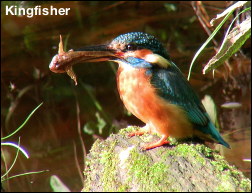
I suppose it had to happen in the wettest Summer for a century that my regular pair of Kingfishers would fail to rear any young this year. They started in March with the first brood being taken by a Mink. A replacement brood was ready to fledge in June then four inches of rain fell and their nesting hole disappeared under ten foot of flood water. A third attempt was made last month with six young due to fledge yesterday. Alas the tunnel was again flooded as a result of last Saturday’s thunderstorms. I was there on Sunday and watched the female take fish into the nesting tunnel only to come out again still with the fish in her bill because the young were drowned inside. It is an event I would not want to witness again and I wonder how many more Kingfishers throughout the whole country have had a similar fate.
The most pleasant event of the week was watching two fledged Hobbies trying to catch prey before their long journey South. With a minimum temperature of only 3°C one night they will soon be on their way.
Along the local canal have been one hundred and thirty five Canada Geese and a Chiff Chaff still singing. In the garden a female Blackcap is regularly eating the honeysuckle berries. A local Swift on the 1st September is the latest I have ever seen.
August 25, 2012 at 8:27 pm
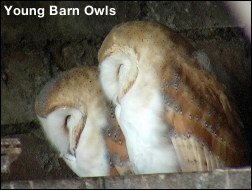
After more than forty years in the waiting last week I was able to watch three recently fledged Hobbies at a secret locality in the Pennines. Feeds occurred in mid air at breath taking speed as the noisy youngsters caught, from the adults, what looked like hirundines and flew off with them to be devoured on dead trees near by. They were constantly hassled by Jackdaws seeking to relieve them of their prey. Despite the elusive nature of Hobbies all my sightings were from a public footpath.
During the last two weeks I have been waiting for two young Barn Owls, in this week’s photo, to leave their nest site and perch on fence posts against the setting sun. Six nights waiting with some wonderful sunsets but alas the young Barn Owls stayed in doors on a water tank where there had been reared. At least one night I was able to save a Chaffinch that lay stunned in the middle of the road. The next car along would have flattened it and I was pleased to be able to move it to the hedgerow where it will have recovered.
In the garden a male Blackcap has been feeding on the ripening berries of the Honeysuckle but has not come regular enough for me to capture it on film.
August 19, 2012 at 1:57 pm
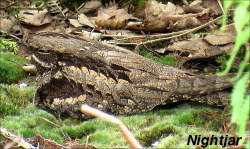
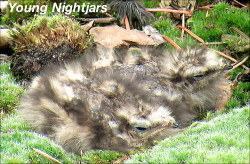
Whilst I am showing my films over the Winter period people readily tell me of some of the nests that they have found during the breeding season.Some promise faithfully to give me a ring if a certain birds breeds again so I can come and photograph it. Usually the phone does not ring but this year, knowing that I needed to film a Nightjar for the next Pennine DVD, I was invited to a nest where the female was brooding two small young. It was exactly forty years since I last saw a Nightjar’s nest so it was a long overdue experience and will be in this year’s DVD.
When I started filming birds more than forty years ago if you wanted to film a nest you had to put up a hide. Times have changed and much of my photography is now done from under a large camouflage cloth that used to cover an army tank! When you are under the cloth you have to sit very still as any movement, however small, can be seen by the bird you are filming. During the week, whilst sat still waiting for a Kingfisher a male Sparrowhawk flew over the stream and clipped my head with its wing. The funniest event I have ever experienced under the cloth was on Islay when I was sat still waiting for a Corncrake to appear. Suddenly a Song Thrush landed on my head with a snail. It proceeded to try and crack the snail by hammering it on my skull. A painful experience!!
On Hopwood the Roe Deer have produced two fawns this year, which is good news. Even better has been the re-appearance of Partridges, which have not been seen for at least five years. They have probably failed to breed with the rains but perhaps next year they may be more successful?
August 12, 2012 at 8:05 am
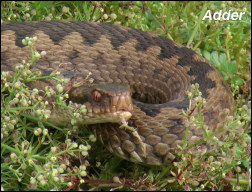
With sunny and warm weather I took the opportunity to visit my Adder site during the week and was well rewarded. Three Adders were enjoying the warmth, together with a very small young one. Unfortunately Buzzards have recently been seen in the area so their future will be in the balance.
One day I set off to continue my search for breeding Hobbies but never got there. As I parked my car I noticed that a pool in the road had Goldfinches, Linnets, Greenfinches and even Siskins coming to drink. When filming wildlife you have to take every opportunity to film whenever it presents itself. I spent several hours filming from the car and ended up with some good shots of male Linnets bringing their young to drink. A totally unplanned event and the search for the Hobby would have to wait.
In the garden we are being visited by at least three Grey Squirrels which are destroying the feeders at an alarming rate. We have never had that many Squirrels in the garden in over forty years.
August 5, 2012 at 1:23 pm
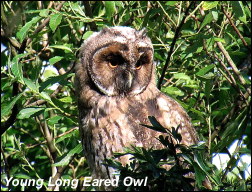
This is the only fledged Long Eared Owl I have seen this year . I spent a magical hour with this bird and eventually it was so used to me that I was able to film it from only twelve feet away as it rested and preened. I went back to it a week later but then it was so wild that it flew when I was thirty feet away!
It always amazes me that whilst you are filming birds circumstances can change without warning. I have recently been filming Barn Owls, under licence, with the male providing me with some good film as he brought prey to the the breeding site, in a barn, well before eight o’clock. There was good evening light and he looked superb as he appeared carrying prey to the young and the female who were in the nest site in an disused water tank. After several weeks the female decided that the young were old enough for her to leave them in the tank during the day. At first I thought that my filming opportunities would now be even better with both adult birds being able to bring food to their three young. This might have been the case but I was not ready for the fact that they did not bring prey until after ten o’clock when there was no light to film. So in one fell swoop my filming was over!
On Hopwood on the fourth there was a steady stream of Curlews moving in a South West direction. Their breeding season is now over and I wonder how successful it has been with all the months of rain. The Birch woods of Hopwood should now be full of young tits but apart from the odd Song Thrush still singing all is silent. It is going to take a long time before its wildlife recovers from this year’s appalling weather.








